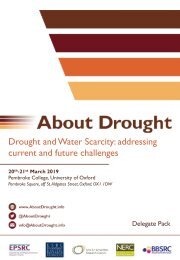About Drought Handbook: Outputs & Impacts
As the UK’s £12m Drought and Water Scarcity (DWS) research programme reaches its conclusion with a final event at The Royal Society in London, this handbook draws together the key outputs and outcomes. The book also features a series of interviews with our leading stakeholders, which highlight how successfully we have met our objectives to produce cutting-edge science that has made a demonstrable impact on how decision-makers manage water scarcity in the UK.
As the UK’s £12m Drought and Water Scarcity (DWS) research programme reaches its conclusion with a final event at The Royal Society in London, this handbook draws together the key outputs and outcomes. The book also features a series of interviews with our leading stakeholders, which highlight how successfully we have met our objectives to produce cutting-edge science that has made a demonstrable impact on how decision-makers manage water scarcity in the UK.
- No tags were found...
You also want an ePaper? Increase the reach of your titles
YUMPU automatically turns print PDFs into web optimized ePapers that Google loves.
stakeholders, regulators and researchers, was a valuable<br />
opportunity for Steve and a small group of Water<br />
Scarcity Team colleagues to extend their contacts<br />
around the UK as well as internationally, and find out<br />
how water resources are managed in other countries.<br />
Those included a key connection with Forestry<br />
Commission research presented by Susan Davies of<br />
the University of Edinburgh, discussing drought-resilient<br />
tree species.<br />
He says: “It was the first time we had heard that anyone<br />
was looking at that for the Scottish Timber Industry, at<br />
the same time we had also started to look at water<br />
resources, policy and ecology plans for the different<br />
sectors in Scotland and we have been able to feed<br />
Susan’s research into those plans.”<br />
Steve had also joined one of DRY’s very popular regional<br />
community workshops, held in the Eden Catchment in<br />
Fife. “It definitely shaped how we produce our reports<br />
and ways to get the right message across, making people<br />
aware that water scarcity is an issue in Scotland, which<br />
helped us in the summer of 2018.<br />
“It brought different people around the same table –<br />
Scottish Water, Government, local farmers … groups<br />
like that were really good for getting other people’s<br />
points of view that we may not always see.”<br />
Then in May 2019 <strong>About</strong> <strong>Drought</strong> held a workshop<br />
for SEPA and Scottish Water in Edinburgh which<br />
enabled a wider audience to discuss the programme’s<br />
23<br />
outputs first-hand.<br />
Steve explains: “That was great because it meant we<br />
could get more people from SEPA to come along<br />
and the focus was on Scottish issues – it is useful to<br />
make use of experiences elsewhere and ensure we are<br />
following consistent approaches with other agencies,<br />
but there are also cases where a Scotland-specific<br />
approach is required.”<br />
As a result of that meeting, SEPA has identified where<br />
it can feed improved data from its monitoring network<br />
into the <strong>Drought</strong> Portal and, in turn, draw from it near<br />
real-time data to better monitor and communicate<br />
situational updates. In the future it is leading to a<br />
collaboration, developing a forecast system providing<br />
advanced, accurate warnings of when water scarcity is<br />
developing.<br />
“We are speaking to CEH about combining our<br />
resources, data and effort to feed our live data into<br />
the <strong>Drought</strong> Portal and we envisage being able to use<br />
the tool with our own reporting which would be a<br />
significant step forward,” says Steve.<br />
SEPA are using <strong>About</strong> <strong>Drought</strong>’s communications<br />
research to inform future messaging for different<br />
audiences, like pre-warning private supply holders of<br />
potential impacts of water scarcity and the need to<br />
protect the environment.<br />
SEPA were inspired by the innovative work by students<br />
from Falmouth University’s School of Communication<br />
Design on how to get water-saving messages across<br />
to hard-to-reach Millennials by <strong>About</strong> <strong>Drought</strong>’s<br />
social science co-ordinator, Dr Rebecca Pearce. With<br />
humorous video clips, posters and social media posts<br />
the students devised effective peer-to-peer campaigns.<br />
Steve explains: “It was really interesting to see their<br />
ideas, it’s a relatively new area to us. We really liked the<br />
ideas they had.<br />
“This wider and better understanding that we have from<br />
<strong>About</strong> <strong>Drought</strong> means we can develop ways to get our<br />
information out there and, importantly, to get a general<br />
understanding that water scarcity is becoming more of<br />
an issue in the future due to climate change.<br />
“It is something everyone needs to think about and<br />
everyone can have an impact.”<br />
“THIS WIDER AND BETTER<br />
UNDERSTANDING THAT WE HAVE<br />
FROM ABOUT DROUGHT MEANS WE<br />
CAN DEVELOP WAYS TO GET OUR<br />
INFORMATION OUT THERE AND,<br />
IMPORTANTLY, TO GET A GENERAL<br />
CONSENSUS THAT WATER SCARCITY<br />
IS BECOMING MORE OF AN ISSUE<br />
IN THE FUTURE DUE TO CLIMATE<br />
CHANGE.”<br />
Interview by Sally Stevens




